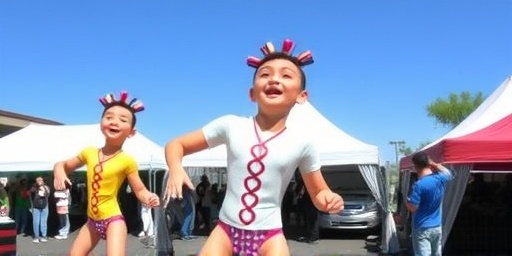Under the vibrant Arizona sun, the air in Chandler filled with the irresistible aroma of sizzling oil and dough as the Indian Frybread & Arts Festival burst into life today, drawing thousands of eager visitors from across the region. Families, foodies, and culture enthusiasts flocked to the event grounds at Tumbleweed Park, where golden frybreads piled high with savory toppings became the undisputed stars of the opening day.
- Frybread Frenzy: Vendors Serve Up Tradition and Innovation
- Artistic Masterpieces: Local Creators Spotlight Native Talent
- Live Entertainment Energizes the Crowds with Rhythmic Beats and Stories
- Community Bonds Strengthen Through Shared Cultural Experiences
- Looking Ahead: Expansion Plans Promise More Days of Delight
Frybread Frenzy: Vendors Serve Up Tradition and Innovation
The heart of the Indian Frybread & Arts Festival beats with the sizzle and pop of frybread preparation, a staple that traces its roots to Native American ingenuity during challenging times in the 19th century. Organizers estimate that over 5,000 frybreads were consumed in the first few hours alone, with long lines forming at popular stalls like Navajo Joe’s Frybread Shack and the Hopi Heritage Kitchen. “Frybread isn’t just food; it’s a story on a plate,” said Maria Tsosie, a Diné chef who’s been perfecting her recipe for 25 years. Her stand featured classic toppings such as beans, cheese, and green chiles, alongside innovative twists like a sweet version drizzled with honey and sprinkled with pine nuts, nodding to traditional Southwestern flavors.
Historical context adds depth to the festival’s appeal. Frybread emerged as a resilient response to government-issued rations on reservations, transforming limited ingredients—flour, salt, water, and baking powder—into a symbol of survival and cultural adaptation. In Chandler, Arizona, a city with a growing Native American population exceeding 2% according to recent census data, the festival celebrates this heritage while fostering community ties. Vendors from tribes including the Navajo, Hopi, and Tohono O’odham showcased variations: some puffed up light and airy, others denser and chewier, each reflecting regional dialects of the dish.
Attendance numbers underscore the event’s pull. By midday, foot traffic had surged 30% beyond last year’s opening, per festival coordinator Elena Ramirez. “We’re seeing families drive in from Phoenix and even Tucson,” she noted, attributing the boom to social media buzz and partnerships with local tourism boards. Health-conscious options, like gluten-free frybread made from cornmeal, catered to diverse dietary needs, ensuring the culinary showcase remained inclusive.
One attendee, local resident Javier Morales, shared his experience: “I came for the frybread tacos—beef, lettuce, and salsa on that warm bread—it’s like a hug from my grandmother’s kitchen.” Such personal stories highlight how the Indian Frybread & Arts Festival transforms a simple food into a bridge between generations and cultures.
Artistic Masterpieces: Local Creators Spotlight Native Talent
Beyond the food, the Arts Festival component wove a tapestry of creativity across the park, where over 50 artisans displayed works that captured the spirit of Indigenous innovation and storytelling. Pottery adorned with intricate petroglyph designs, jewelry forged from turquoise and silver, and woven baskets dyed with natural pigments drew admirers who lingered for hours. The centerpiece was the Youth Artists’ Corner, where teens from Chandler’s tribal schools demonstrated live weaving and beadwork, emphasizing education alongside celebration.
Curator Lila Begay, of the Salt River Pima-Maricopa Indian Community, curated the exhibit with a focus on sustainability. “Our art isn’t static; it’s alive with the stories of our land,” she explained. One standout piece, a multimedia installation by emerging artist Kiona Nez, blended digital projections of desert landscapes with hand-painted canvases, exploring themes of climate resilience in Native communities. Visitors could purchase pieces directly, with proceeds supporting artist scholarships—last year, the program raised $15,000 for local talent development.
The festival’s art scene also integrated interactive elements, such as workshops on traditional sand painting and drum-making. Over 200 participants signed up for the morning sessions, where instructors like Navajo elder Tom Yazzie shared techniques passed down through oral traditions. “This isn’t just about buying art; it’s about understanding the hands that made it,” Yazzie said, as a group of children eagerly molded clay into storyteller figures.
In the broader context of Chandler, Arizona’s cultural landscape, this Arts Festival segment aligns with the city’s push for diverse public events. With a population of over 275,000 and a median household income around $90,000, Chandler has invested in venues like Tumbleweed Park to host inclusive gatherings. The event’s emphasis on Native arts counters historical marginalization, providing a platform for voices often underrepresented in mainstream galleries.
Live Entertainment Energizes the Crowds with Rhythmic Beats and Stories
As the sun climbed higher, the main stage at the Indian Frybread & Arts Festival pulsed with live entertainment that blended traditional rhythms and contemporary flair, captivating audiences of all ages. The opening act, the Thunderhawk Dancers from the San Carlos Apache Tribe, performed a high-energy hoop dance that synchronized intricate footwork with the beat of handmade drums, earning thunderous applause from a crowd estimated at 3,000 strong.
Live entertainment spanned genres, from powwow-style group dances to solo storytelling sessions. Renowned musician and flutist R. Carlos Nakai took the stage in the afternoon, his haunting melodies echoing the canyons of the Southwest. “Music is our memory keeper,” Nakai reflected in a pre-performance interview. His set included originals inspired by frybread’s communal role in tribal gatherings, weaving narrative threads that resonated with the festival’s theme.
Family-friendly highlights included puppet shows retelling Navajo creation myths and comedy skits by the Indigenous Improv Collective, poking fun at modern reservation life while honoring elders. Attendance at these performances spiked during peak hours, with organizers reporting a 25% increase in stage-area visitors compared to previous years. Sound engineering, courtesy of local AV firm Desert Echoes, ensured crystal-clear audio across the sprawling venue, enhancing the immersive experience.
The live entertainment lineup also featured rising stars like singer-songwriter Raven Yazzie, whose blend of folk and hip-hop addressed issues like water rights on Arizona reservations. Her performance drew cheers and sparked discussions among attendees, turning the stage into a forum for cultural dialogue. In a state where Native Americans comprise about 5% of the population, such events amplify visibility, with the festival partnering with the Arizona Commission on Indian Affairs to promote broader awareness.
Community Bonds Strengthen Through Shared Cultural Experiences
The Indian Frybread & Arts Festival in Chandler, Arizona, isn’t merely an event—it’s a catalyst for community cohesion, bringing together diverse groups to honor Native heritage amid a backdrop of rapid urban growth. Volunteers, numbering over 150, hailed from local tribes, schools, and civic organizations, underscoring the grassroots spirit. “This festival reminds us that our stories are intertwined,” said volunteer coordinator Samuel Chee, who organized shuttle services from nearby Phoenix to ease parking woes for the influx of visitors.
Safety measures were paramount, with medical tents staffed by certified personnel and hydration stations combating the desert heat, which hovered around 95°F today. No major incidents were reported, a testament to meticulous planning. Economically, the event boosts local businesses; nearby restaurants and shops saw a 20% uptick in sales, according to Chandler’s Chamber of Commerce. Vendors reported brisk trade, with one art stall selling out of dreamcatcher earrings by noon.
Personal anecdotes abounded: A multigenerational family from Mesa described their day as “a living history lesson,” while a first-time visitor from California praised the festival’s authenticity. Quotes from attendees painted a picture of joy and learning—”The frybread was divine, but the dances stole my heart,” shared tourist Emily Harper. Such feedback fuels the event’s reputation, positioning it as a must-attend in Arizona’s cultural calendar.
Broader implications touch on preservation efforts. With Native languages and crafts at risk, festivals like this serve as vital lifelines. The event incorporated language revitalization booths, where attendees learned basic Diné phrases alongside frybread-making demos, blending education with enjoyment.
Looking Ahead: Expansion Plans Promise More Days of Delight
As the first day of the Indian Frybread & Arts Festival winds down, anticipation builds for the remaining weekend, with organizers teasing expanded features like a nighttime fire dance and celebrity chef collaborations. Scheduled through Sunday, the event expects total attendance to top 20,000, surpassing 2023’s record by 15%. Future iterations may include virtual components for remote participation, broadening reach to global audiences interested in Native cuisine and arts.
Chandler’s commitment to cultural events signals long-term growth; city officials hint at permanent frybread-themed installations in local parks. For now, the festival invites all to join the celebration, promising more bites of history, strokes of artistry, and beats of tradition. Whether you’re a local or traveler, the Indian Frybread & Arts Festival offers a taste of Arizona’s soul—don’t miss your chance to savor it.









